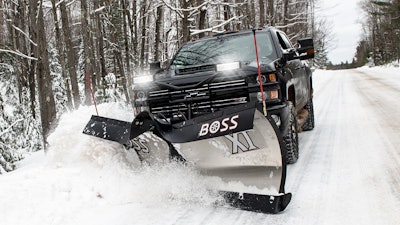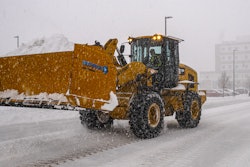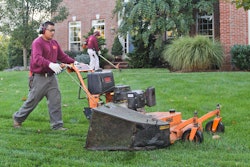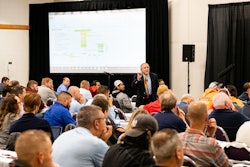
In anticipation of a healthy dose of snow to come in the 2021-22 winter season, it appears the snow and ice management industry remains strong.
Leaders of the two largest snow contractor associations, Martin Tirado, executive director of Snow & Ice Management Association (SIMA) and Kevin Gilbride, executive director of the Accredited Snow Contractors Association (ASCA) agree that the industry is in a strong position coming off a healthy 2020-21 season.
“The industry is healthy provided it snows next winter,” Gilbride says. “We are coming off an average, to above average winter in most areas. As long as we see average snowfall the industry will enjoy another healthy season.”
Looking back
Going into the 2020-21 winter, snow removal contractors were coming off one or two lower than average snowfall years. Combined with the COVID-19 pandemic, there was potential for a dual impact of reduced revenue.
With the light snowfall the previous season, some customers with seasonal contracts were likely looking at that and saying, “we paid for a whole bunch of stuff that we never got.” Conversely, contractors that were operating on largely seasonal contracts in areas where there was little snow did very well because of the lower expenses.
The challenge becomes maintaining those customers on those seasonal contracts after a low snow winter. Going into the season, the thought was the pandemic would only compound the issue.
Ultimately, COVID-19 had minimal impact on the snow and ice management industry. “It did have some customers reduce services, or limit servicing the entire property, but in all, this industry is more impacted by lack of snow,” Gilbride said.
Not surprisingly, snow and ice management services were quickly identified as essential services during the pandemic. “It was so essential to have snow and ice services to clear those properties, so that business and transportation and healthcare could continue,” Tirado said. “I think from a business perspective, that was a positive.”
Admittedly, there were still some challenges and there will be some ongoing ones, such as keeping up with the best practices on safety, sanitation, and cleanliness. “In trucks, compact equipment, or environments where people weren't able to kind of distance from each other, it was more challenging in that regard,” Tirado said. “I think people battled through it and a lot of equipment operation is done by a single person.”
Across the service industry, one challenge that was consistent was the crunch on obtaining labor. That's one pain point that will not be going away soon. Also, some companies did face some lost revenue depending on their customer base. Those with retail accounts as primary clients were facing more of a challenge due to closures. “The retail sector certainly took a huge hit, and that did flow done to some contractors, but through communication many were able to come to agreements on providing proper services,” Gilbride said.
Heading into the 2021-22 winter season, the challenge will be adjusting to the changes to occupancy of buildings and properties. “It’s going to be a struggle for some who serviced restaurants and retail locations that may have closed,” Tirado said. “There is some loss of revenue and opportunity there. However, from another perspective there’s also the expansion in other areas such as the shipping warehouses and distribution centers. Those properties are large and take up a lot of acreage and there is a significant opportunity to get new business from those environments.”
Overall, the number of sites and paved surfaces that need snow and ice removal did not change significantly. Always, the need only continues to grow as the population increases.
New opportunities
“I think there are a lot of opportunities for new business for contractors,” Tirado said.
Over the course of the year, he said there have been some company mergers and acquisitions, leaving some markets more viable for new business.
Although as a contractor you may have been deemed essential and made it through the pandemic, your customers may not have. They will be looking to renegotiate their contracts to save a few dollars.
“This is something they should be doing at this time every year,” Gilbride said. “However, if you have customers that have severely limited your ability to service them, then look to replace them with accounts that are more profitable.”
The pandemic was (hopefully) a one-time impact. The weather or climate whole other issue.
“I think contractors need to take a look at weather volatility,” Tirado said. “We're living in a world where there's much more weather volatility and that means properties and facilities are going to need to be prepared. Even in areas where there may not have been snow and ice in the past there are more of these variety of storms.”
Climate projections suggest more cold and warmer cycles back and forth, leading to bigger storms and more ice-related storms. From a contractor perspective that could lead to growth potential in the deicing or anti-icing management services.
“It’s kind of like disaster planning,” Tirado said. “This past winter the Mid-Atlantic state got a few massive snowstorms in short periods of time. People are going to need to be prepared for the worst. I think that is going to be a positive for the snow and ice management industry.”
Tech on ice
With the change in weather patterns, Tirado believes the use of liquids and blending of liquids with granular material will continue to grow as more contractors are learning and adopting the science behind it.
“You look at the risk management side of it, ice and ice storms are actually more of a higher risk for slip and falls,” he said. “If there are more ice storms or freeze thaw events that require ice management, there's just going to be more of a need for that service to potentially mitigate the impact of slip and falls.”
To counteract the impact of ice, Tirade feels that use of liquids and some different products besides just rock salt will continue to grow and expand again. “More manufacturers are getting into brine making, or equipment that does brine making and more contractors are learning the science side of it and improving their knowledge to be able to do it themselves and then store it on onsite at their facilities,” Tirado said.
Outside of the use of liquids and brine products, more technology continues to come to the snow and ice management market.
Software related to verification and data tracking continually is improving and the price point is becoming more affordable for the smaller businesses to put into their budgets. Tirado said it is becoming more of a standard practice to have such tracking as part of the business.
Data tracking relates again back to risk management and protection of the company, operations, and people.
Another area of expansion within the industry is robotics. While such technology is growing fast in the lawn care sector, there is movement within the snow and ice industry as well.
“I think it's going to take longer just because the sophistication of snow and ice is not as is not as easy because of the changing factors in winter weather,” Tirado said. “Robotics will play a role in alleviating p one of the big pain points, the human and personnel side of finding reliable workforce to perform services.”
Currently, there is potential for some of the larger properties such as airports or other large sites with wide open areas to utilize trucks being operated robotically.
“Is that going to happen in mass adoption this next year probably not, but I think at some point in the future its coming,” Tirado said, citing the ongoing development of the self-driving and electric vehicles. “It’s being tested out there now, it’s only a matter of time before you’re going to see it in greater quantity.”
Smaller properties may still be a more logistical challenge but for the larger sites such as distribution centers or airports where it’s like windrowing you might do on highways it is certainly possible.
Getting into snow
Adding snow and ice is what helps you become a year-round service provider for your customers and it’s another revenue source.
“If you have people and equipment sitting idle in the winter months, it can be a great additional business,” Gilbride said.
Everyone in particularly the trades are looking for good people. “If you can keep your crew employed with a good compensation year-round, that's going to help you maintain those employees,” Tirado said.
The snow and ice industry has its challenges such as new equipment and odd hours. Unlike a paver or landscaper, if it rains one day, you can return and do the outside work the next day. For snow and ice, it’s got to be done immediately, which opens the door for profit if you are the one offering the service.
With the labor shortage, there are fewer looking to get into the business, meaning there are opportunities for contractors that are willing to take that next step.
“At the same time, the most successful snow contractor loves the industry,” Gilbride added. “If you are not excited about, I would caution you to think twice before adding it as a service.”
The two association executives agree that it is important to know what you’re getting into if you’re seeking to get into the snow and ice management industry.
“Make sure your team is committed,” Gilbride said. “This is not an 8 a.m. to 4 p.m. job with schedules. They are like firefights. When there is a snow event, they go. It doesn’t matter the time or day when it snows it needs to be serviced.” This means Thanksgiving, Christmas, New Year’s Eve, birthdays, and anniversaries can all be missed. None of those stop the industry from operating.
He also says to ensure you understand your costs and price accordingly. “Too many people get into the industry and don’t understand financial end of things and end up out of the industry very quickly,” Gilbride says.
To counter the quick exit, Tirado says it is important to establish a network of acquaintances and friends from adjacent markets to learn from and lean on in times of trouble. “That's one of the things I've noticed in this industry is people are very willing to help each other and help each other be better,” he said. “
There’s no doubt, getting into the snow and ice industry means working in tough conditions and that network of knowledge and assistance will show up.
“If you structure your business correctly, it could be a nice profit revenue generator for contractors that are really in that kind of entrepreneurial mindset,” Tirado said. “It really kind of helps perform a service that’s needed in the community.”


![Doosan Bobcat Wacker Neuson Stack 2ec Js Pb V6e[1]](https://img.greenindustrypros.com/mindful/acbm/workspaces/default/uploads/2025/12/doosan-bobcat-wacker-neuson-stack2ecjspbv6e1.CPyyz8ubHn.png?auto=format%2Ccompress&bg=fff&fill-color=fff&fit=fill&h=100&q=70&w=100)








![Doosan Bobcat Wacker Neuson Stack 2ec Js Pb V6e[1]](https://img.greenindustrypros.com/mindful/acbm/workspaces/default/uploads/2025/12/doosan-bobcat-wacker-neuson-stack2ecjspbv6e1.CPyyz8ubHn.png?ar=16%3A9&auto=format%2Ccompress&bg=fff&fill-color=fff&fit=fill&h=135&q=70&w=240)








